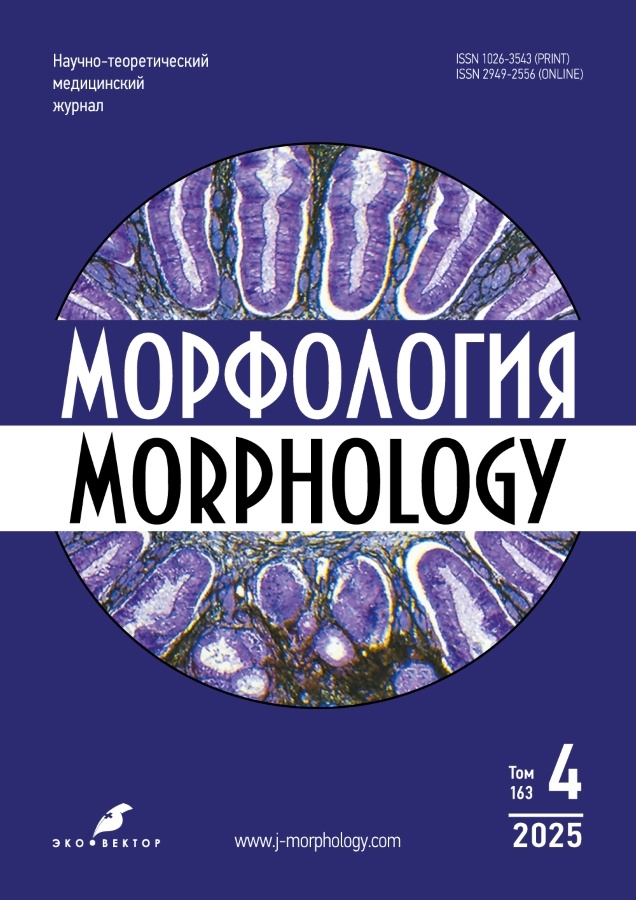人工智能在肝脏纤维化、变性和炎症损伤形态学诊断中的方法论应用
- 作者: Novikova T.O.1, Melikbekyan A.A.2, Borbat A.M.3
-
隶属关系:
- LLC Laboratoires de Genie
- MIREA-Russian Technological University
- MVZ Pathologie Spandau
- 期: 卷 163, 编号 4 (2025)
- 页面: 273-282
- 栏目: Reviews
- ##submission.dateSubmitted##: 19.01.2025
- ##submission.dateAccepted##: 31.03.2025
- ##submission.datePublished##: 23.10.2025
- URL: https://j-morphology.com/1026-3543/article/view/646399
- DOI: https://doi.org/10.17816/morph.646399
- EDN: https://elibrary.ru/FENJGS
- ID: 646399
如何引用文章
详细
非肿瘤性肝脏疾病广泛存在,且仍然是诊断中的难题。根据现代数据,在俄罗斯,成人非酒精性脂肪肝的流行率约为25%。肝脏纤维化、脂肪和气球性变性、炎症浸润以及肝组织坏死的形态学验证依赖于专家的主观看法,这使得标准化变得困难。因此,开发客观且自动化的形态学变化分析方法可以显著提高诊断的可重复性。本综述分析了现代人工智能方法在非肿瘤性肝脏病变形态学诊断中的应用,重点讨论了神经网络算法的主要应用方向,包括组织学图像的分类和分割。此外,还评估了开发的模型在识别主要形态学特征,如纤维化、气球变性、脂肪变性和炎症浸润方面的有效性。
本综述使用了来自Google学术和PubMed数据库的文献。搜索时间范围为2020至2025年,最终纳入了22篇文献。
研究表明,人工智能模型在肝脏病变的诊断中表现出较高的准确性,但其效果仍依赖于样本量、实验室间差异、形态学模式、显微镜放大倍数以及切片染色方法。为进一步推动这一方向的研究,未来需要增加公开数据量并标准化方法。尽管如此,模型也能在较小的数据集上开发,这使得该技术对广泛的研究人员群体更具可访问性。
全文:
作者简介
Tatiana O. Novikova
LLC Laboratoires de Genie
编辑信件的主要联系方式.
Email: tn.path1910@yandex.ru
ORCID iD: 0000-0002-1686-5629
SPIN 代码: 9993-9645
俄罗斯联邦, Moscow
Ashot A. Melikbekyan
MIREA-Russian Technological University
Email: melikbekyan.ashot@yandex.ru
ORCID iD: 0009-0003-6470-4891
SPIN 代码: 8683-6870
俄罗斯联邦, Moscow
Artyom M. Borbat
MVZ Pathologie Spandau
Email: aborbat@yandex.ru
ORCID iD: 0000-0002-9699-8375
SPIN 代码: 8948-9169
德国, Berlin
参考
- Qu H, Minacapelli CD, Tait C, et al. Training of computational algorithms to predict NAFLD activity score and fibrosis stage from liver histopathology slides. Comput Methods Programs Biomed. 2021;207:106153. doi: 10.1016/j.cmpb.2021.106153 EDN: VZIOAF
- Puri M. Automated machine learning diagnostic support system as a computational biomarker for detecting drug-induced liver injury patterns in whole slide liver pathology images. Assay Drug Dev Technol. 2020;18(1):1–10. doi: 10.1089/adt.2019.919 EDN: PZAYLW
- Allaume P, Rabilloud N, Turlin B, et al. Artificial intelligence-based opportunities in liver pathology-A systematic review. Diagnostics (Basel). 2023;13(10):1799. doi: 10.3390/diagnostics13101799 EDN: CEMHRQ
- Maev IV, Andreev DN, Kucheryavyy YuA. Prevalence of non-alcoholic fat disease liver in russian federation: meta-analysis. Consilium Medicum. 2023;25(5):313–319. doi: 10.26442/20751753.2023.5.202155 EDN: BNGAZT
- Nam D, Chapiro J, Paradis V, et al. Artificial intelligence in liver diseases: Improving diagnostics, prognostics and response prediction. JHEP Rep. 2022;4(4):100443. doi: 10.1016/j.jhepr.2022.100443 EDN: WARMHY
- Taylor-Weiner A, Pokkalla H, Han L, et al. A machine learning approach enables quantitative measurement of liver histology and disease monitoring in NASH. Hepatology. 2021;74(1):133–147. doi: 10.1002/hep.31750 EDN: JQEBBT
- Naglah A, Khalifa F, El-Baz A, Gondim D. Conditional GANs based system for fibrosis detection and quantification in hematoxylin and eosin whole slide images. Med Image Anal. 2022;81:102537. doi: 10.1016/j.media.2022.102537 EDN: FTOHBE
- Bosch J, Chung C, Carrasco-Zevallos OM, et al. A machine learning approach to liver histological evaluation predicts clinically significant portal hypertension in NASH cirrhosis. Hepatology. 2021;74(6):3146–3160. doi: 10.1002/hep.32087 EDN: TBAWLW
- Ercan C, Kordy K, Knuuttila A, et al. A deep-learning-based model for assessment of autoimmune hepatitis from histology: AI(H). Virchows Arch. 2024;485(6):1095–1105. doi: 10.1007/s00428-024-03841-5 EDN: TLAMKC
- Arjmand A, Angelis CT, Christou V, et al. Training of deep convolutional neural networks to identify critical liver alterations in histopathology image samples. Applied Sciences. 2020;10(1):42. doi: 10.3390/app10010042
- Roy M, Wang F, Vo H, et al. Deep-learning-based accurate hepatic steatosis quantification for histological assessment of liver biopsies. Lab Invest. 2020;100(10):1367–1383. doi: 10.1038/s41374-020-0463-y EDN: JRLXIF
- Sjöblom N, Boyd S, Manninen A, et al. Automated image analysis of keratin 7 staining can predict disease outcome in primary sclerosing cholangitis. Hepatol Res. 2023;53(4):322–333. doi: 10.1111/hepr.13867 EDN: YBGSRL
- Sulyok M, Luibrand J, Strohäker J, et al. Implementing deep learning models for the classification of Echinococcus multilocularis infection in human liver tissue. Parasit Vectors. 2023;16(1):29. doi: 10.1186/s13071-022-05640-w EDN: SUNVTS
- Baek EB, Lee J, Hwang JH, et al. Application of multiple-finding segmentation utilizing Mask R-CNN-based deep learning in a rat model of drug-induced liver injury. Sci Rep. 2023;13(1):17555. doi: 10.1038/s41598-023-44897-8 EDN: OBHXFO
- Ramot Y, Deshpande A, Morello V, et al. Microscope-based automated quantification of liver fibrosis in mice using a deep learning algorithm. Toxicol Pathol. 2021;49(5):1126–1133. doi: 10.1177/01926233211003866 EDN: ORWPSE
- Hwang JH, Lim M, Han G, et al. Preparing pathological data to develop an artificial intelligence model in the nonclinical study. Sci Rep. 2023;13(1):3896. doi: 10.1038/s41598-023-30944-x EDN: TACKEA
- Hwang JH, Kim HJ, Park H, et al. Implementation and practice of deep learning-based instance segmentation algorithm for quantification of hepatic fibrosis at whole slide level in Sprague-Dawley rats. Toxicol Pathol. 2022;50(2):186–196. doi: 10.1177/01926233211057128 EDN: UVMNUH
- Hwang JH, Lim M, Han G, et al. Segmentation algorithm can be used for detecting hepatic fibrosis in SD rat. Lab Anim Res. 2023;39(1):16. doi: 10.1186/s42826-023-00167-2 EDN: GZLDOM
- Baek EB, Hwang JH, Park H, et al. Artificial intelligence-assisted image analysis of Acetaminophen-induced acute hepatic injury in Sprague-Dawley rats. Diagnostics (Basel). 2022;12(6):1478. doi: 10.3390/diagnostics12061478 EDN: NVUYFC
- Sjöblom N, Boyd S, Manninen A, et al. Chronic cholestasis detection by a novel tool: automated analysis of cytokeratin 7-stained liver specimens. Diagn Pathol. 2021;16(1):41. doi: 10.1186/s13000-021-01102-6 EDN: YGONZK
- Ashour AS, Hawas AR, Guo Y. Comparative study of multiclass classification methods on light microscopic images for hepatic schistosomiasis fibrosis diagnosis. Health Inf Sci Syst. 2018;6(1):7. doi: 10.1007/s13755-018-0047-z EDN: AUEQQI
- Jana A, Qu H, Rattan P, et al. Deep learning based NAS score and fibrosis stage prediction from CT and pathology data. arXiv. 2020;arXiv:2009.10687. doi: 10.48550/arXiv.2009.10687
- Heinemann F, Gross P, Zeveleva S, et al. Deep learning-based quantification of NAFLD/NASH progression in human liver biopsies. Sci Rep. 2022;12(1):19236. doi: 10.1038/s41598-022-23905-3 EDN: MRKSDP
- Preechathammawong N, Charoenpitakchai M, Wongsason N, et al. Development of a diagnostic support system for the fibrosis of nonalcoholic fatty liver disease using artificial intelligence and deep learning. Kaohsiung J Med Sci. 2024;40(8):757–765. doi: 10.1002/kjm2.12850 EDN: LXBSFF
- Heinemann F, Birk G, Stierstorfer B. Deep learning enables pathologist-like scoring of NASH models. Sci Rep. 2019;9(1):18454. doi: 10.1038/s41598-019-54904-6 EDN: EDWDDY
- Noureddin M, Goodman Z, Tai D, et al. Machine learning liver histology scores correlate with portal hypertension assessments in nonalcoholic steatohepatitis cirrhosis. Aliment Pharmacol Ther. 2023;57(4):409–417. doi: 10.1111/apt.17363 EDN: DLEHME
- Kleiner DE, Brunt EM, Van Natta M, et al. Design and validation of a histological scoring system for nonalcoholic fatty liver disease. Hepatology. 2005;41(6):1313–1321. doi: 10.1002/hep.20701
补充文件





